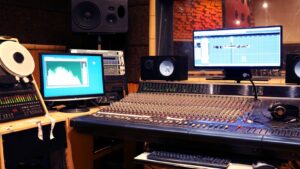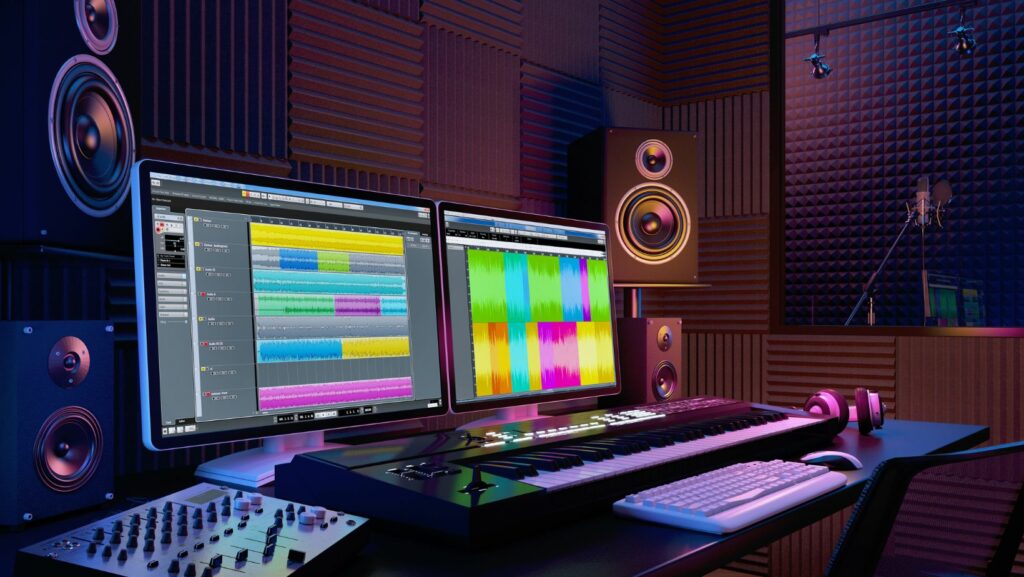Embarking on the journey of audio recording can seem daunting at first. It’s a world filled with a dizzying array of equipment, each piece promising to be the key to crystal clear sound. But don’t fret, this article is here to guide you through the maze of audio recording equipment.
Audio Recording Equipment
 In the realm of sound capture, one encounters several types of equipment. Microphones, amplifiers, and mixers form the backbone of an audio recording setup. Taking a moment to comprehend the role of each tool can substantially boost the quality of your sound.
In the realm of sound capture, one encounters several types of equipment. Microphones, amplifiers, and mixers form the backbone of an audio recording setup. Taking a moment to comprehend the role of each tool can substantially boost the quality of your sound.
Microphones, essentially the first point of sound capture, come in an array of types like condenser, dynamic, and ribbon. Sound engineers routinely use condenser microphones for recording vocals and high-frequency instruments, given their sensitivity to sound variations. Contrarily, dynamic microphones, known for their robustness, find use in live performances for their capacity to withstand high sound levels. The classic ribbon microphones cater to professionals seeking to capture the warmth and richness in sounds, a go-to choice for vintage audio recording.
Amplifiers, also known as preamps, function to amplify the microphone’s low voltage signals into a level perceivable by human ears before it is sent to the mixer. Choose preamps based on the expected sound quality, as it adds tonal character to the sound.
Finally, mixers blend multiple sound sources into a well-balanced output. They allow control over volume, pitch, tone, and dynamics, translating individual sounds into a cohesive auditory experience. Remember, a good mixer provides the flexibility to create a balanced mix, enhancing the overall recording quality.
Best Microphones for Audio Recording
 Selecting the ideal microphone for audio recording goes beyond the utility of the three main types—condenser, dynamic, and ribbon. Specificity takes precedence when it comes to choosing the right microphone. For example, the Shure SM7B, universally recognized for its sound quality and versatility, makes an excellent choice for robust vocals and podcast recordings. Neumann U87 Ai, on the other hand, stands out in studio recording for vocals and instruments, owing to its superior audio fidelity. However, for those on a budget, the Audio-Technica AT2020 provides decent performance, proving broad functionality doesn’t need an extravagant price tag. Lastly, the AKG Pro Audio C414 XLII serves multiple recording scenarios with its nine polar patterns, demonstrating adaptability in the field. These microphones, each distinct in their capabilities, symbolize the array of options available for achieving optimal audio recording outcomes.
Selecting the ideal microphone for audio recording goes beyond the utility of the three main types—condenser, dynamic, and ribbon. Specificity takes precedence when it comes to choosing the right microphone. For example, the Shure SM7B, universally recognized for its sound quality and versatility, makes an excellent choice for robust vocals and podcast recordings. Neumann U87 Ai, on the other hand, stands out in studio recording for vocals and instruments, owing to its superior audio fidelity. However, for those on a budget, the Audio-Technica AT2020 provides decent performance, proving broad functionality doesn’t need an extravagant price tag. Lastly, the AKG Pro Audio C414 XLII serves multiple recording scenarios with its nine polar patterns, demonstrating adaptability in the field. These microphones, each distinct in their capabilities, symbolize the array of options available for achieving optimal audio recording outcomes.
Mixing Consoles: The Heart of Audio Production
 Transitioning from microphones, the next critical component in an audio recording setup is the mixing console. It’s often mentioned as the heart of audio production due to its multiple functionalities. Primarily, mixing consoles help balance different sound levels, manipulate signals, and route audio to achieve the desired output.
Transitioning from microphones, the next critical component in an audio recording setup is the mixing console. It’s often mentioned as the heart of audio production due to its multiple functionalities. Primarily, mixing consoles help balance different sound levels, manipulate signals, and route audio to achieve the desired output.
Two common types of mixing consoles are analog and digital. Analog mixers are favored for their hands-on control and unique coloration of sound. A perfect example is the Behringer Xenyx Q802USB Mixer, known for its low noise levels and straightforward design. On the other side, digital mixers provide enhanced versatility and recall of settings. The Yamaha TF5, with its 48-input digital mixing console, is an instance celebrating precision and functionality.
Headphones and Monitors: The Ears of Audio Recording
Topping off the audio recording equipment journey, it’s crucial not to overlook the role of headphones and monitors. They’re the ears of the process, providing the final checkpoint before the sound reaches the audience. High-quality headphones, like the Sennheiser HD 800 S, offer unparalleled detail and precision, while studio monitors, such as the Yamaha HS8, deliver accurate, uncolored sound for critical listening.
Remember, it’s not just about having the right equipment; it’s about how you use it. So, invest wisely, practice regularly, and keep exploring the fascinating world of audio recording. The right tools, used correctly, can transform your sound from average to exceptional.

